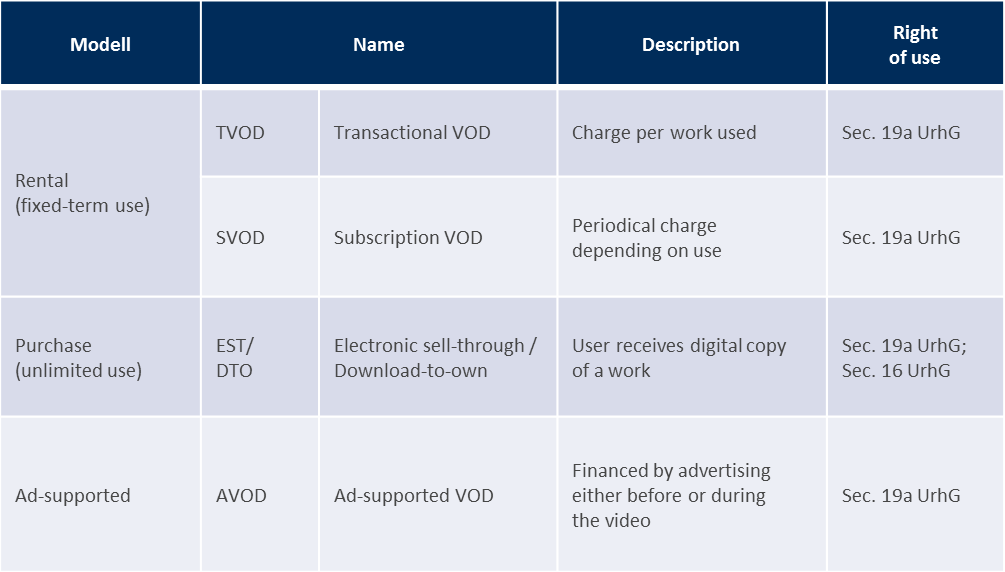Video on demand – legal framework conditions
Early this year, the video-on-demand provider, Netflix, launched its video platform –already successfully positioned in the USA – on the German market and thereby increased the competition for internet users. The market launch created quite a stir as Netflix does not restrict itself to merely buying in third-party content but also commissions the production of blockbuster series such as “House of Cards”.
In addition to the exclusive service it offers its subscribers, the US company is able to secure further sources of income by licensing the rights to the first screening of series to conventional broadcasting corporations. For example, the first screening rights for the coming seasons of “House of Cards” have been licensed to Sky. Almost all major players on the editorial VoD market, such as Amazon Prime, Instant Video, Maxdome and Watchever offer their own programmes and series. YouTube, the market leader on the online video market, on the other hand, manages entirely without content of its own.
Despite these efforts, VOD platforms have not yet managed to supersede either the classic DVD/Blu-ray market or conventional television stations. Nevertheless, the increase in the consumption of video-on-demand content is serious competition for the cinema, DVD/Blu-ray and TV media and, at the same time, provides a further opportunity for the monetization of previously produced content. It therefore comes as no surprise that broadcasting companies have set up their own streaming services, such as RTL Now, 7TV and Sky Snap, which are proving particularly popular. Within a week of its first screening, the award-winning crime drama “Im Schmerz geboren” (e.g. Grimme-Preis 2015 and Goldene Kamera Awards 2015) was watched 343,000 times on “Mediathek”, the VOD site of the German broadcasting corporation, ARD.
Forms of video on demand
Video on demand differs from conventional broadcasting in that – unlike linear TV – the user can consume the content when and where he or she pleases. The way in which VOD services are presented differs depending on the particular distribution type and technology. If the user is only permitted to rent and use a video for a limited period, a distinction is made between TVOD (Transactional VOD) where a separate charge is made for every work used, and SVOD (Subscription VOD) where a charge is made periodically, e.g. by way of a monthly fee – irrespective of actual use – and is thus similar to a flat rate. If the customer is granted the right of use for an unlimited period, this is known as “electronic sell-through” (EST) or “download to own” (DTO). The user hereby receives a digital copy of the work. Advertising-supported VOD (AVOD) is characterized by the appearance of advertising either during or before the desired content – similar to a commercial break during broadcasting.
As the user has access to video content from any location and at any time he or she chooses, video on demand is not subject to broadcasting law under Section 20 of the German Copyright Act (Urhebergesetz – UrhG) but is instead covered by the law on public availability pursuant to Section 19 a UrhG under which the copyright owner can grant VOD platforms exploitation rights pursuant to Section 31 UrhG. If the business model of the VOD service enables download, this requires an additional permit for the sublicensing of the right of reproduction arising from Section 16 UrhG. An overview of this situation is presented below:

Video on demand is an independent exploitation right within the meaning of Section 31, paragraph 5 UrhG and therefore cannot be compared to classic broadcasting. The signal is not transmitted to several receivers at the same time. Rather, the place, time and content are determined by the user him or herself. VOD services are also capable of fundamentally changing the use of audiovisual content. With regard to the principle of assignment tied to purpose (Zweckübertragungslehre) applicable in copyright law, it is therefore advisable to expressly include VOD rights in the catalogue of rights listed in licence agreements.
Broadcasting-law aspects of video on demand
Under broadcasting law, the provisions relevant for VOD services, particularly AVOD, include the advertising provisions of the Interstate Broadcasting Treaty (Rundfunkstaatsvertrag – RStV). As a result of the reference made in Section 58, paragraph 3 RStV, TV-like internet services, including not only the video-on-demand services provided by Netflix, Maxdome, Amazon Prime etc., but under certain circumstances also corporate or privately run YouTube channels, are subject to the same advertising provisions as classic broadcasting. In particular, the provisions on subliminal advertising, product placement and the rule of the separation of advertising from editorial content (which, pursuant to Section 58, paragraph 1 RStV, also applies to non-TV-like internet services) are of considerable practical relevance.
Public broadcasting corporations must also particularly observe Section 11 d RStV which fundamentally sets out that the programmes they produce are accessible online for only up to seven days after broadcast.
Outlook
The strong growth on the market for VOD platforms is set to continue in the next few years. High potential growth particularly exists in the increasing consolidation of broadcasting and video on demand on smart TVs which, due to internet access and HbbTV, have a user interface that enables the easy integration of online video stores and seamless switching between broadcasting and VOD services. In addition, the desire to watch videos online is particularly prevalent among younger media users and this is also expected to result in further growth in the coming years.
Well
informed
Subscribe to our newsletter now to stay up to date on the latest developments.
Subscribe now





.jpg?t=a-s&arw=16&arh=9&arm=focuspoint&w=500)